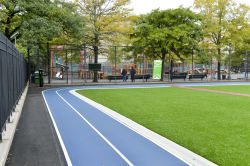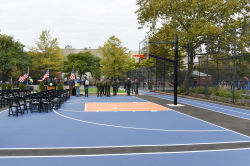Park Slope Playground
Park Slope Playground
This playground, located between Lincoln Place and Berkley Place and between Fifth and Sixth Avenues, lies in one of the finest historic neighborhoods in Brooklyn. Taking its name from its topography, Park Slope sits on a gentle hill that stretches from the Gowanus Canal to Prospect Park, which was designed by Frederick Law Olmsted and Calvert Vaux in 1865. Park Slope is bounded by Prospect Park to the east, Fourth Avenue to the west, Flatbush Avenue to the north, and Green-Wood Cemetery to the south. It is divided into the smaller neighborhoods of North Slope, adjacent to Prospect Heights, near Grand Army Plaza, and South Slope, which runs from Ninth Street down to Green-Wood Cemetery.
First inhabited by the Canarsee Indians, the land that Park Slope now occupies was colonized by the Dutch in the 1600s and farmed for more than 200 years. During the Revolutionary War, the area became a site of national historic importance. At the beginning of the Battle of Long Island on August 27, 1776, approximately 4,000 British soldiers defeated the outnumbered American forces at Battle Pass, in what is now Prospect Park. Park Slope’s bucolic period ended in the 1870s, when horse-drawn rail carts began running to the park, and rich New Yorkers gravitated to its urban, but still peaceful, streets. Edwin Clarke Litchfield (1815-1885), a railroad businessman and lawyer whose villa off Prospect Park West now serves as the Brooklyn Parks headquarters, had purchased huge tracts of farmland in the 1850s and began selling them to home developers after the Civil War. By the end of the century, people were scrambling to build mansions along Prospect Park West, which was known as the Gold Coast from Grand Army Plaza to North First Street. Prospect Park developed into an oasis.
In South Slope, by the Gowanus Canal, the growing Italian and Irish population that worked along the waterfront built more modest row houses. Today, Park Slope is famous for its tranquil, tree-lined streets and for some of New York’s most well preserved row houses, stately brownstones, and Queen Anne, Renaissance Revival, and Romanesque mansions. A revitalization movement, begun in the 1960s and 1970s, is still going on today. Culturally, Park Slope is one of the richest neighborhoods in the city.
The city acquired this land in 1959, and the playground opened in 1964 as P.S. 282 Playground, after the adjacent school. Parks renamed it Park Slope Playground in 1985. Three years later, the Park Slope Playground Committee formed and successfully advocated the renovation of this and other playgrounds. City Council Member Ken Fisher and Borough President Howard Golden raised $927,000 for the reconstruction of Park Slope Playground. Constructed between 1994 and 1995, improvements included state-of-the-art play equipment, swings, tennis and basketball courts, a spray shower, safety surfacing, benches, drinking fountains, and game tables. A three-part facility, the playground accommodates everyone from tots to adults. An eagle weathervane perches atop the public restroom, amid a grove of London planetrees, a species known for its ability to survive under harsh environmental conditions.
Check out your park's Vital Signs
Clean & Safe
Green & Resilient
Empowered & Engaged Users
Share your feedback or learn more about how this park is part of a
Vital Park System




